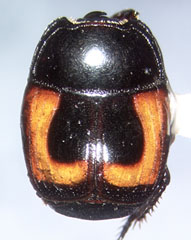Histerini
Michael S. Caterino- Atribalus (1 species)
- Rhypochares (3 species)
- Margarinotus (~100 species)
- Macrolister (~16 species)
- Pachylister (~21 species)
- Hister (~270 species) (non-monophyletic)
- Merohister (~5 species)
- Neohister (1 species)
- Spilodiscus (~9 species)
- Zabromorphus (~21 species)
- Teinotarsus (2 species)
- Campylorhabdus (2 species)
- Neosantalus (1 species)
- Contipus (~17 species)
- Eugrammicus (2 species)
- Exorhabdus (~11 species)
- Omotropis (1 species)
- Epiglyptus (1 species)
- Psiloscelis (~7 species)
- Eudiplister (~8 species)
- Atholus (~79 species)
- Asiaster (3 species)
- Seitzister (1 species)
- Coptosternus (1 species)
- Hubenthalia (1 species)
- Megalocraerus (1 species, probably Exosternini) (incertae sedis)
Introduction
Histerini contains some of the most commonly encountered histerids. Throughout the tropical and subtropical parts of Africa and the Americas, Histerini are the most abundant histerids associated with dung. Several predaceous Histerini have in fact been widely introduced (in Australia and Hawaii, in particular) to help control flies breeding in cattle dung. In the Old World, dung associations are by far the most common for species of Histerini. However, there are many exceptions to this 'rule'
Characteristics
Histerini are fairly easily characterized as those histerids lacking labral setae, possessing a well developed prosternal lobe, having the anterior mesosternal margin truncate or emarginate (never projecting), and having straight, complete antennal club annuli. They are generally larger species, >4mm, shiny, and black or with red maculae.
Discussion of Phylogenetic Relationships
The study of relationships within Histerini is largely uncharted territory. The monophyly of the tribe itself remains to be conclusively demonstrated. Several genera have recently been removed to Platysomatini and Exosternini, and the affinities of some others listed above are yet questionable. Additionally, within Histerini, few of the genera have been adequately defined, and the limits of most are debateable. Hister is a 'trash can' genus, which is likely paraphyletic with respect to most or all of the other genera in the tribe, and it desperately needs phylogenetic study on a worldwide scale. Some preliminary attempts toward this end have been made (Caterino, unpublished), and both male and female genitalia appear highly informative across the group. However, only a small proportion of taxa has been examined.
References
Caterino, M. S. 1998. A phylogenetic revision of Spilodiscus Lewis (Coleoptera: Histeridae). Journal of Natural History 32:1129-1168.
Caterino, M. S. 1999. The taxonomy and phylogenetics of the coenosus group of Hister Linnaeus. University of California Publications in Entomology 119:1-75 +plates.
Ohara, M. 1989. On the species of the genus Margarinotus from Japan. Insecta Mastumurana (N.S.) 41:1-50.
Wenzel, R. L. 1944. On the classification of histerid beetles. Fieldiana, Zoology 28:51-151 +plates.
Information on the Internet
Masahiro Ohara's Histeridae home page: HisteriniTitle Illustrations

| Scientific Name | Hister lucanus |
|---|---|
| Location | southwestern North America |
| Specimen Condition | Dead Specimen |
| Image Use |
 This media file is licensed under the Creative Commons Attribution-ShareAlike License - Version 3.0. This media file is licensed under the Creative Commons Attribution-ShareAlike License - Version 3.0.
|
| Copyright |
© 2002
Michael S. Caterino

|
About This Page
Michael S. Caterino

Santa Barbara Museum of Natural History, Santa Barbara, California, USA
Page copyright © 2002 Michael S. Caterino
 Page: Tree of Life
Histerini.
Authored by
Michael S. Caterino.
The TEXT of this page is licensed under the
Creative Commons Attribution License - Version 3.0. Note that images and other media
featured on this page are each governed by their own license, and they may or may not be available
for reuse. Click on an image or a media link to access the media data window, which provides the
relevant licensing information. For the general terms and conditions of ToL material reuse and
redistribution, please see the Tree of Life Copyright
Policies.
Page: Tree of Life
Histerini.
Authored by
Michael S. Caterino.
The TEXT of this page is licensed under the
Creative Commons Attribution License - Version 3.0. Note that images and other media
featured on this page are each governed by their own license, and they may or may not be available
for reuse. Click on an image or a media link to access the media data window, which provides the
relevant licensing information. For the general terms and conditions of ToL material reuse and
redistribution, please see the Tree of Life Copyright
Policies.
- First online 07 March 2002
Citing this page:
Caterino, Michael S. 2002. Histerini. Version 07 March 2002 (under construction). http://tolweb.org/Histerini/9393/2002.03.07 in The Tree of Life Web Project, http://tolweb.org/








 Go to quick links
Go to quick search
Go to navigation for this section of the ToL site
Go to detailed links for the ToL site
Go to quick links
Go to quick search
Go to navigation for this section of the ToL site
Go to detailed links for the ToL site